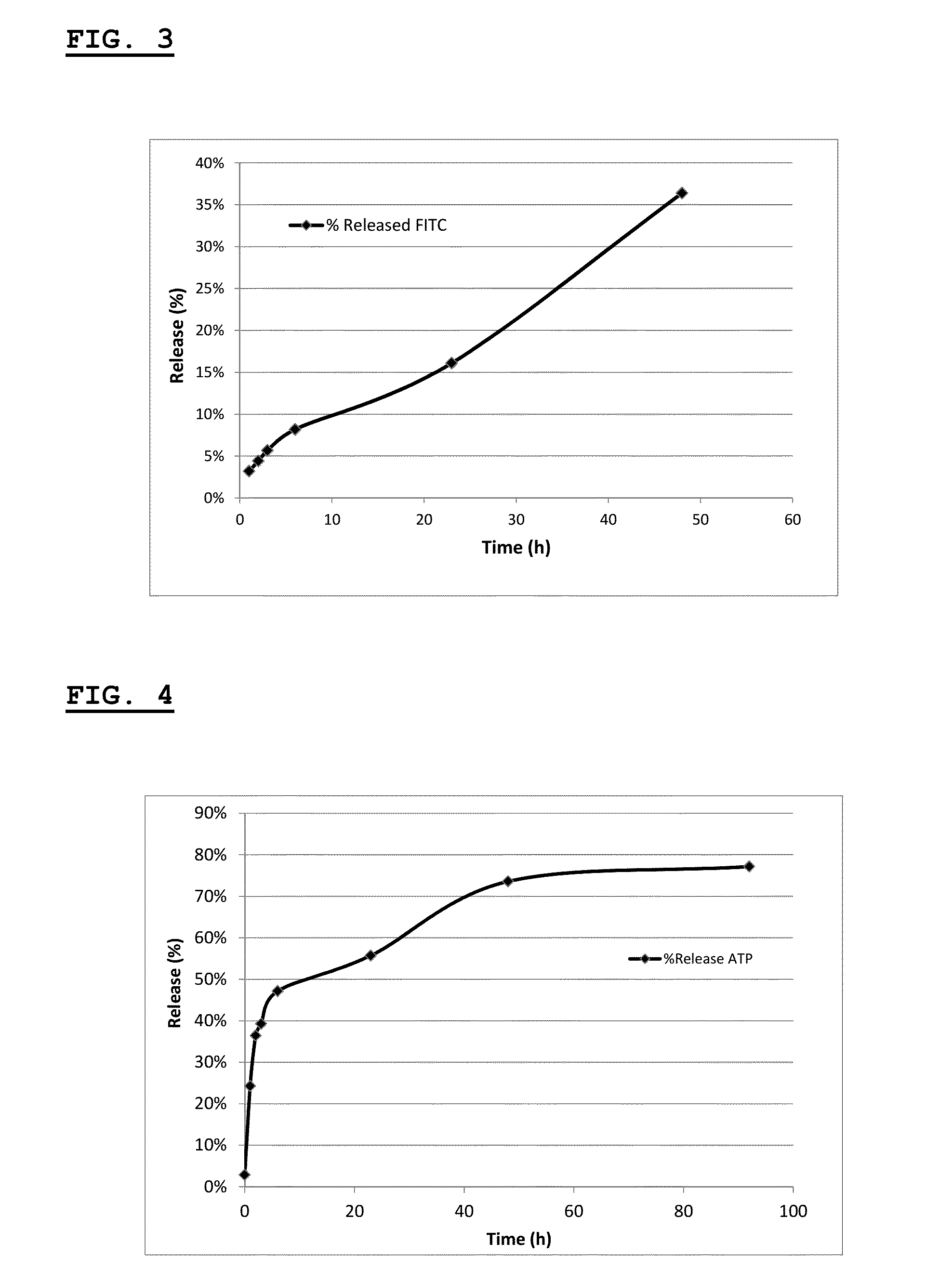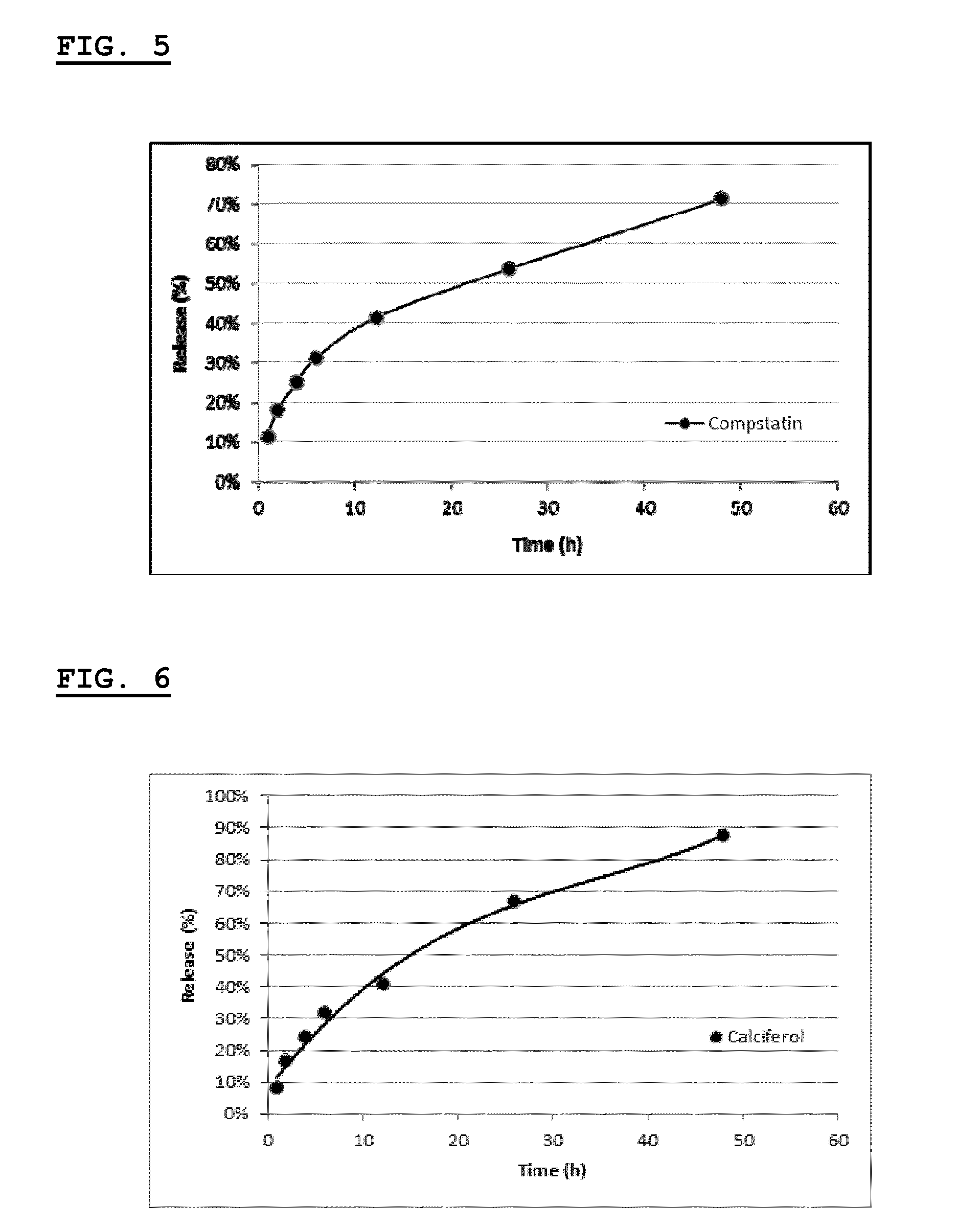Induction of Antigen-Specific Tolerance by Peripheral Phagocytosis
- Summary
- Abstract
- Description
- Claims
- Application Information
AI Technical Summary
Benefits of technology
Problems solved by technology
Method used
Image
Examples
example 1
Thermo-Gelling PLGA-PEG-PLGA Hydrogels
[0258]This example describes the synthesis and characterization of thermogelling PLGA-PEG-PLGA hydrogels.
1.1. Synthesis of Thermogelling PLGA-PEG-PLGA Hydrogels
[0259]The biodegradable triblock polymer described in this example has a PLG / PEG weight ratio of 2.3 (70 / 30), and a lactide / glycolide molar ratio of approx. 15 / 1. Synthesis of the triblock copolymer is performed according to published protocols (Qiao et al., 2005).
1.1.1. Copolymer Synthesis
[0260]Polyethylene glycol (PEG 1000) was purchased from Fluka, poly(DL-lactide) from Sigma, glycolide (1,4-Dioxane-2,5-dione) from Sigma, and stannous 2-ethylhexanoate from Aldrich.
[0261]A total of 25 g of DL-lactide, glycolide and PEG are used for polymerization (16.6 g DL-lactide, 0.9 g glycolide, 7.5 g PEG 1000). Under nitrogen atmosphere, PEG 1000 is dried under vacuum and stirring at 120° C. for 2 h in a vigorously dried Erlenmeyer reaction flask. Then the reaction flask is filled with dry argon. ...
example 2
PLGA-PEG-PLGA / PS-Liposome Composites
[0271]This example describes the synthesis and characterization of thermogelling PLGA-PEG-PLGA hydrogels containing phosphatidylserine (PS)-liposomes.
2.1. Synthesis of Thermogelling PLGA-PEG-PLGA Hydrogels
[0272]The biodegradable triblock polymer described in this example has a PLG / PEG weight ratio of 2.3 (70 / 30), and a lactide / glycolide molar ratio of approx. 15 / 1. Synthesis of the triblock copolymer is performed as described in Example 1.1.
2.2. Synthesis of PS-Liposomes
[0273]This example describes the synthesis of unilamellar PS-liposomes from a lipid mixture of phosphatidyldserine (PS), either 1,2-Dipalmitoyl-sn-glycero-3-phospho-L-serine sodium salt (Sigma-Aldrich), 1-palmitoyl-2-oleoyl-sn-3-glycerophospho-L-serine (POP-L-S) or bovine brain phosphatidyldserin (Avanti Polar Lipids), phosphatidylcholine (PC), either 1,2-Dipalmitoyl-sn-glycero-3-phosphocholine (Sigma-Aldrich), 1-palmitoyl-2-oleoyl-sn-3-glycerophosphocholine (POPC) or egg phosphati...
example 3
PLGA-PEG-PLGA / PS-Man-Liposome Composites
[0280]This example describes the synthesis and characterization of thermogelling PLGA-PEG-PLGA hydrogels containing liposomes with phosphatidylserine (PS) and mannose (MAN) or oligomannose (e.g. Man3) on their surface.
3.1. Synthesis of Thermogelling PLGA-PEG-PLGA Hydrogels
[0281]The biodegradable triblock polymer described in this example has a PLG / PEG weight ratio of 2.3 (70 / 30), and a lactide / glycolide molar ratio of approx. 15 / 1. Synthesis of the triblock copolymer is performed as described in Example 1.1.
3.2. Conjugation of Mannose Residues to Lipid Molecules
[0282]This example describes the synthesis of three types of mannosylated lipids including conjugates of mannotriose and phosphatidylethanolamine (Man3-PE), conjugates of mannose and N-glutaryl-phosphatidylethanolamine (Man-NGPE), and conjugates of mannose and cholesterol via a butyl spacer (Man-C4-Chol).
3.2.1. Conjugation of Mannotriose to Phosphatidylethanolamine
[0283]A mixture of 5 μ...
PUM
| Property | Measurement | Unit |
|---|---|---|
| Temperature | aaaaa | aaaaa |
| Temperature | aaaaa | aaaaa |
| Temperature | aaaaa | aaaaa |
Abstract
Description
Claims
Application Information
 Login to View More
Login to View More - R&D
- Intellectual Property
- Life Sciences
- Materials
- Tech Scout
- Unparalleled Data Quality
- Higher Quality Content
- 60% Fewer Hallucinations
Browse by: Latest US Patents, China's latest patents, Technical Efficacy Thesaurus, Application Domain, Technology Topic, Popular Technical Reports.
© 2025 PatSnap. All rights reserved.Legal|Privacy policy|Modern Slavery Act Transparency Statement|Sitemap|About US| Contact US: help@patsnap.com



